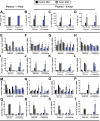Δ-5 Fatty Acid Desaturase FADS1 Impacts Metabolic Disease by Balancing Proinflammatory and Proresolving Lipid Mediators
- PMID: 29074585
- PMCID: PMC5746431
- DOI: 10.1161/ATVBAHA.117.309660
Δ-5 Fatty Acid Desaturase FADS1 Impacts Metabolic Disease by Balancing Proinflammatory and Proresolving Lipid Mediators
Abstract
Objective: Human genetic variants near the FADS (fatty acid desaturase) gene cluster (FADS1-2-3) are strongly associated with cardiometabolic traits including dyslipidemia, fatty liver, type 2 diabetes mellitus, and coronary artery disease. However, mechanisms underlying these genetic associations are unclear.
Approach and results: Here, we specifically investigated the physiological role of the Δ-5 desaturase FADS1 in regulating diet-induced cardiometabolic phenotypes by treating hyperlipidemic LDLR (low-density lipoprotein receptor)-null mice with antisense oligonucleotides targeting the selective knockdown of Fads1. Fads1 knockdown resulted in striking reorganization of both ω-6 and ω-3 polyunsaturated fatty acid levels and their associated proinflammatory and proresolving lipid mediators in a highly diet-specific manner. Loss of Fads1 activity promoted hepatic inflammation and atherosclerosis, yet was associated with suppression of hepatic lipogenesis. Fads1 knockdown in isolated macrophages promoted classic M1 activation, whereas suppressing alternative M2 activation programs, and also altered systemic and tissue inflammatory responses in vivo. Finally, the ability of Fads1 to reciprocally regulate lipogenesis and inflammation may rely in part on its role as an effector of liver X receptor signaling.
Conclusions: These results position Fads1 as an underappreciated regulator of inflammation initiation and resolution, and suggest that endogenously synthesized arachidonic acid and eicosapentaenoic acid are key determinates of inflammatory disease progression and liver X receptor signaling.
Keywords: atherosclerosis; eicosanoids; lipogenesis; macrophages; metabolic diseases.
© 2017 American Heart Association, Inc.
Conflict of interest statement
A.D.G., R.C.S., A.L.B., R.N.H., A.C.B., D.F., R.Z., B.E.S., R.E.M., D.S.A., J.S.P., M.S., and J.M.B. all have no conflicts of interest to declare. R.G.L. is an employee at Ionis Pharmaceuticals, Inc. (Carlsbad, CA).
Figures






Comment in
-
Knockdown of Δ-5 Fatty Acid Desaturase Is More Than Just a Fad.Arterioscler Thromb Vasc Biol. 2018 Jan;38(1):6-8. doi: 10.1161/ATVBAHA.117.310382. Arterioscler Thromb Vasc Biol. 2018. PMID: 29282245 No abstract available.
Similar articles
-
Targeted Knockdown of Hepatic Δ-5 Fatty Acid Desaturase FADS1 Aggravates Atherosclerosis in ApoE-/- Mice.Front Biosci (Landmark Ed). 2024 Mar 29;29(4):131. doi: 10.31083/j.fbl2904131. Front Biosci (Landmark Ed). 2024. PMID: 38682200
-
Macrophage-Associated Lipin-1 Enzymatic Activity Contributes to Modified Low-Density Lipoprotein-Induced Proinflammatory Signaling and Atherosclerosis.Arterioscler Thromb Vasc Biol. 2018 Feb;38(2):324-334. doi: 10.1161/ATVBAHA.117.310455. Epub 2017 Dec 7. Arterioscler Thromb Vasc Biol. 2018. PMID: 29217509 Free PMC article.
-
ERV1/ChemR23 Signaling Protects Against Atherosclerosis by Modifying Oxidized Low-Density Lipoprotein Uptake and Phagocytosis in Macrophages.Circulation. 2018 Oct 16;138(16):1693-1705. doi: 10.1161/CIRCULATIONAHA.117.032801. Circulation. 2018. PMID: 29739755 Free PMC article.
-
Delta-5 and delta-6 desaturases: crucial enzymes in polyunsaturated fatty acid-related pathways with pleiotropic influences in health and disease.Adv Exp Med Biol. 2014;824:61-81. doi: 10.1007/978-3-319-07320-0_7. Adv Exp Med Biol. 2014. PMID: 25038994 Review.
-
A 'desaturase hypothesis' for atherosclerosis: Janus-faced enzymes in omega-6 and omega-3 polyunsaturated fatty acid metabolism.J Nutrigenet Nutrigenomics. 2009;2(3):129-39. doi: 10.1159/000238177. Epub 2009 Sep 23. J Nutrigenet Nutrigenomics. 2009. PMID: 19776640 Review.
Cited by
-
Resolvin D1 and D2 reduce SARS-CoV-2-induced inflammatory responses in cystic fibrosis macrophages.FASEB J. 2021 Apr;35(4):e21441. doi: 10.1096/fj.202001952R. FASEB J. 2021. PMID: 33749902 Free PMC article.
-
Specialized Proresolving Lipid Mediators: A Potential Therapeutic Target for Atherosclerosis.Int J Mol Sci. 2022 Mar 15;23(6):3133. doi: 10.3390/ijms23063133. Int J Mol Sci. 2022. PMID: 35328553 Free PMC article. Review.
-
Effect of atorvastatin on lipoxygenase pathway-related gene expression in an in vitro model of lipid accumulation in hepatocytes.FEBS Open Bio. 2023 Apr;13(4):606-616. doi: 10.1002/2211-5463.13552. Epub 2023 Mar 9. FEBS Open Bio. 2023. PMID: 36637998 Free PMC article.
-
Genomics of Postprandial Lipidomics in the Genetics of Lipid-Lowering Drugs and Diet Network Study.Nutrients. 2021 Nov 10;13(11):4000. doi: 10.3390/nu13114000. Nutrients. 2021. PMID: 34836252 Free PMC article.
-
Relationship between Polyunsaturated Fatty Acid Metabolism and Atherosclerosis.Rev Cardiovasc Med. 2024 Apr 9;25(4):142. doi: 10.31083/j.rcm2504142. eCollection 2024 Apr. Rev Cardiovasc Med. 2024. PMID: 39076540 Free PMC article. Review.
References
Publication types
MeSH terms
Substances
Grants and funding
LinkOut - more resources
Full Text Sources
Other Literature Sources
Medical

